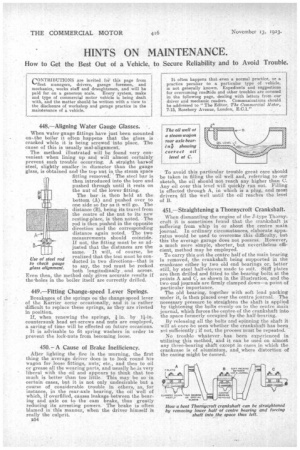HINTS ON MAINTENANCE.
Page 46

If you've noticed an error in this article please click here to report it so we can fix it.
How to Get the Best Out of a Vehicle, to Secure Reliability and to Avoid Trouble.
CONTRIBUTIONS are invited for this page from `-'fleet managers, drivers, garage foremen, and mechanics, works staff and draughtsmen, and will be paid for on a generous scale. Every system, make and type of commercial motor vehicle i.s being dealt with, and the matter should be written with a view to the disclosure of workshop and garage practice in the maintenance of a vehicle. It often happens that even a normal practice, or a practice peculiar to a particular type of vehicle, is not generally pown. Expedients and suggestions for overcoming roadside and other troubles are covered in the following page, dealing with letters from our driver and mechanic readers. Communications should be addressed to "The Editor, The Commercial Motor, 7-15, Rosebery Avenue, London, E.C.1."
448.—Aligning Water Gauge Glasses. • •
When water gauge fittings have just been mounted on-the boiler it often happens that the glass is cracked while it is being screwed into place. The cause of this is usually mal-alignment.
The method illustrated will be found very convenient when lining up and will almost certainly prevent such trouble occurring. A straight barsof steel, slightly smaller in diameter than the gauge glass, is obtained and the top lint in, the steam space fitting removed: The steel bar is then introduced into the bore and pushed through until it rests on the nut of the lower fitting.
The bar is, then held at the bottom (A) and pushed over to one side so far as it will go. The distance (B), being its travel from the centre of the nut to its new resting-place, is then noted. The rod is then pushed in the opposite direction and the corresponding distance again noted. The two measurements should coincide. If not, the fitting must be so adjusted that the distances are the same. It will, of course, be realized that the test must be conducted in two directions—that is to say, the rod must be rocked both longitudinally and across. Even then, the method only gives accurate results if i the‘holes n the boiler itself are correctly drilled.
Use of steel rod to check gauge glass alignment.
449.—Fitting Change-speed Lever Springs.
Breakages of the springs on the change-speed lever of the Karrier occur occasionally, and it is rather difficult to replace these springs, as they are riveted in position.
If, when renewing the springs, 1. in. by II-in. countersunk head set-screws and nuts are employed, a saving of time will be effected on future occasions.
It is advisable to fit spring washers in order to prevent the lock-nuts from becoming loose.
450. A Cause of Brake Inefficiency.
After lighting the fire in the morning, the first thing the average driver does is to look round his wagon for loose fittings, nuts, etc., and then to oil or grease all the wearing parts, and usually he-is very liberal with the oil and appears to think that too much is better than too little. This may be so in certain cases, but it is not only undesirable but a course of considerable trouble in others, as, for instance, in the rear-axle bearing, the oil well of which, if overfilled, causes leakage between the bearing and axle on to the cam 'brake, thus greatly reducing its arresting powers. The brake is often blamed in this manner, when the driver himself is really the culprit.
B54 • To avoid this particular trouble great care should be taken in filling the oil well and, referring to our sketch, the oil should not reach any higher than C. Any oil over this level will quickly run out. Filling is effected through A, in which is a plug, and most drivers, fill the well until the oil reaches the level of B.
451.—Straightening a Thornycroft Crankshaft.
When dismantling the engine of the J-type Thornycroft it is sometimes found that the crankshaft is suffering from whip in or about the centre main journal. In ordinary circumstances, elaborate apparatus would be used to overcome this difficulty, but this the average garage does not possess. However, a much more simple, shorter, but nevertheless efficient, method may be employed. To carry this out the centre half of the main bearing is removed, the crankshaft. being supported in the crankcase either by two old end bearings or, better still, by steel half-sleeves made to suit. Stiff plates are then drilled and fitted to the bearing bolts at the points A and C, as shown in the illustration, and the two end journals are firmly clamped down—a point of particular importance.
The old bearing, together with soft lead packing under it, is then placed over the centre journal. The necessary pressure to straighten the shaft is applied by tightening the bolts evenly on to the centre main journal, which forces the centre of the crankshaft into the space formerly occupied by the half-bearing.
By releasing all the bolts and spinning the shaft it will at once he seen whether the crankshaft has been set sufficiently ; if not, the process must be repeated. — No trouble whatever, has been experienced in utilizing this method, and it can be used on almost any three-bearing shaft except in cases in which the crankcase is of aluminium, and where distortion of the casing might be Caused.
















































